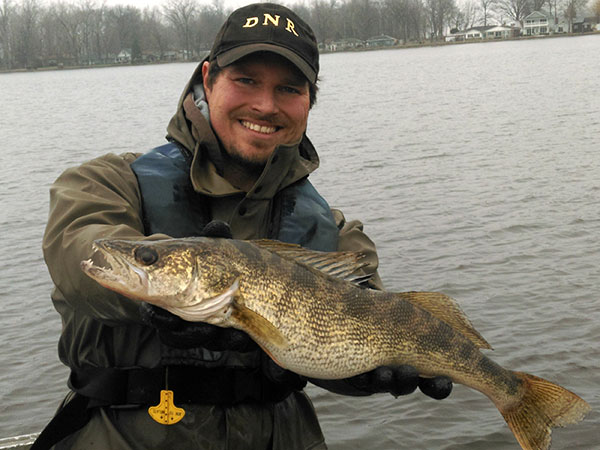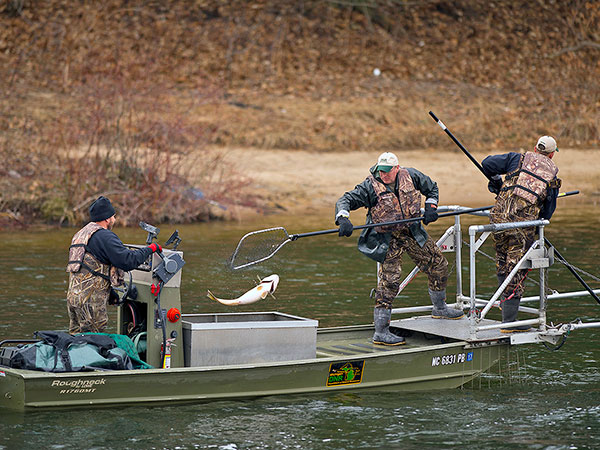- Details
By Louie Stout
 Indiana biologist Jamie Pejza shows off a Lake of Woods walleye netted during survey.The St. Joseph River isnt the only burgeoning walleye fishery on South Bends doorstep.
Indiana biologist Jamie Pejza shows off a Lake of Woods walleye netted during survey.The St. Joseph River isnt the only burgeoning walleye fishery on South Bends doorstep.
Indiana biologists say a pretty good one continues to show promise at Lake of the Woods in Bremen.
Biologist Tom Bacula spent a few days last month sampling the lakes walleye population with a netting project and came away pretty satisfied.
I am pretty happy with the catch of 15- to 18-inch walleyes we saw, said Bacula. They looked very healthy and had great color. We didnt get any of the giants Ive heard anglers talk about, but some nice keeper fish.
The DNR gang set fine mesh traps on sand bars in water 5 to 7 feet deep then checked them daily.
- Details
(Provided by Michigan DNR)
 Biologists working shock boat capture walleyes for egg taking purposes.As many anglers know, much of Michigans inland-waters walleye fishery is supported by hatchery-raised fish. What many dont know is that the source of those fish - the Muskegon River, below Croton Dam - is supported by hatchery-raised fish, too.
Biologists working shock boat capture walleyes for egg taking purposes.As many anglers know, much of Michigans inland-waters walleye fishery is supported by hatchery-raised fish. What many dont know is that the source of those fish - the Muskegon River, below Croton Dam - is supported by hatchery-raised fish, too.
"Theres not a lot of natural reproduction in the system, said Rich ONeal, the Department of Natural Resources fisheries biologist who oversees the Muskegon River watershed. Were getting very low production in the river. Were not sure why, but we think water velocity or water temperature could have something to do with it. We know we get good natural reproduction further upstream.
There are 3 to 4 billion eggs laid here when theyre spawning, but were just not getting fry production.
It took a stocking effort to rebuild the Muskegon River population after it collapsed in the 1960s. ONeal said sea lamprey predation - the preying of one animal on another - on adult walleyes was part of the problem, but alewife predation on juveniles also was a factor. We saw that all over the Great Lakes, he said.
- Details
(Provided by Indiana DNR)
Anglers are wasting no time taking advantage of the early season walleye bite on several northern Indiana lakes.
The best reports are coming from Lake Maxinkuckee and Lake of the Woods in Marshall County, Winona Lake in Kosciusko County, Sylvan Lake in Noble County and Crooked Lake in Steuben County.
Fishing is best after sunset as walleye move into the shallows and attempt to spawn.
Although some natural reproduction occurs, the overall success is not enough to support these hatchery-dependent fisheries.
Most walleyes caught this time of year are males in 2 to 4 feet of water on windswept shorelines or shallow submerged islands. Suspended jerk baits work well, especially those with rattles. Extremely slow stop-and-start retrieves are effective, and most hits occur when the bait is not moving.
While most anglers are fishing from boats, those brave enough to put on a pair of waders are having some success at Lake Maxinkuckee and Winona Lake.
Walleye fishing tips and information on statewide walleye waters can be found at wildlife.IN.gov/3279.htm.
- Details
(Provided by Michigan DNR)
 Erie daily walleye possession limit remains at six.The Michigan DNR announced that the daily possession limit for walleyes in Michigan's waters of Lake Erie will remain at six through April 30, 2016.
Erie daily walleye possession limit remains at six.The Michigan DNR announced that the daily possession limit for walleyes in Michigan's waters of Lake Erie will remain at six through April 30, 2016.
In 2011 Michigan adopted a process for setting creel limit regulations that allows the DNR to use real-time population data instead of using year-old survey results. This process parallels one adopted by Ohio in 2010.
"This regulations process is critical to helping us manage walleyes in Lake Erie in a timely manner," said DNR Lake Erie Basin Coordinator Jim Francis. "In order to do that, we have to set regulations in March instead of the previous autumn."
Michigan's daily possession limit for walleyes on Lake Erie is based on its share of the Total Allowable Catch (TAC) for the lake, which is determined by the Lake Erie Committee under the guidance of the Great Lakes Fishery Commission. The TAC generally is based on overall abundance of walleyes; the committee establishes quotas for each jurisdiction based on the percentage of habitat for adult walleyes in each jurisdiction's waters of the lake. The daily limit is based on a formula that projects how many walleyes anglers can keep but still remain within the quota.





